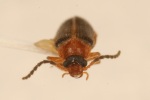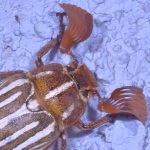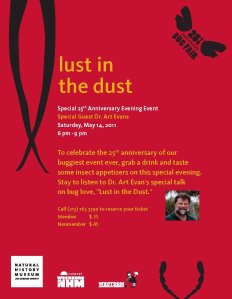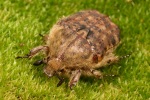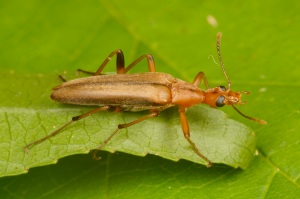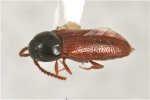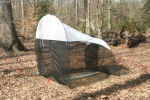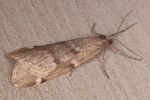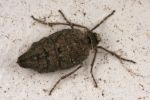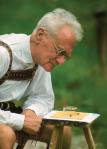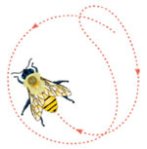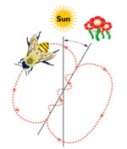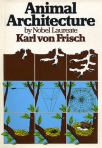By Arthur V. Evans
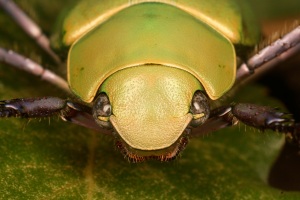 I can still remember the very first Chrysina that I ever saw alive in Arizona. It was August 5, 1973 and Bob Duff and I had just set up our black lights in Bog Springs Campground in Madera Canyon. A soft-spoken man sporting a white t-shirt, khakis, and a crew cut came into our camp and introduced himself as Gayle Nelson. Only later did I discover that Dr. Nelson was one of the world’s leading authorities of jewel beetles (Buprestidae).
I can still remember the very first Chrysina that I ever saw alive in Arizona. It was August 5, 1973 and Bob Duff and I had just set up our black lights in Bog Springs Campground in Madera Canyon. A soft-spoken man sporting a white t-shirt, khakis, and a crew cut came into our camp and introduced himself as Gayle Nelson. Only later did I discover that Dr. Nelson was one of the world’s leading authorities of jewel beetles (Buprestidae).
As the sun slowly set, the oaks all around us came alive with the buzzings of beetles. As Bob,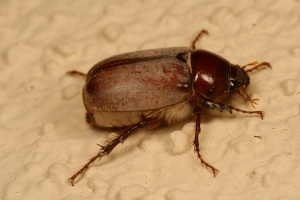 Gayle, and I conversed, my eyes darted nervously this way and that to each and every buzz in the bushes. This was my first night of black lighting in Southeastern Arizona’s Sky Islands and I did not want to miss any choice beetles! I did not know then that most of this crepuscular beetle activity was just the mating and feeding frenzy of several species of plain brown or black June beetles (Phyllophaga).
Gayle, and I conversed, my eyes darted nervously this way and that to each and every buzz in the bushes. This was my first night of black lighting in Southeastern Arizona’s Sky Islands and I did not want to miss any choice beetles! I did not know then that most of this crepuscular beetle activity was just the mating and feeding frenzy of several species of plain brown or black June beetles (Phyllophaga).
 Just as darkness had completely descended upon us, I heard a bigger buzz followed by a thud. There on the sheet in front of me was an apple green beetle on its back with its lavender legs clawing at the air. I picked up the gorgeous beetle with my thumb and forefinger, only to discover that it’s powerful legs were tipped with needle-sharp claws. In spite of this surprisingly painful encounter, I was not about to let go of my very first Beyer’s jewel scarab, C. beyeri.
Just as darkness had completely descended upon us, I heard a bigger buzz followed by a thud. There on the sheet in front of me was an apple green beetle on its back with its lavender legs clawing at the air. I picked up the gorgeous beetle with my thumb and forefinger, only to discover that it’s powerful legs were tipped with needle-sharp claws. In spite of this surprisingly painful encounter, I was not about to let go of my very first Beyer’s jewel scarab, C. beyeri.
For several years afterwards the abundance of Chrysina at my lights were used as a barometer of sorts. I used their numbers, rightly or wrongly, as a way of measuring my success during many summer nights of black lighting in the mountains of Southeastern Arizona. Eventually my sensibilities began to change.
During the 1990’s, I collected specimens of C. beyeri and C. gloriosa alive and took them back to California for display in the Ralph M. Parsons Insect Zoo at the Natural History Museum of Los Angeles County, where I worked as the director. Both species thrived for several months on diets of oak leaves and juniper, respectively. Although the captive scarabs produced plenty of grubs, I made no effort to rear them to adulthood. To this day I regret not writing a formal description of the larva of Beyer’s jewel scarab and submitting it for publication; as of this writing, the immature stages of this species remain undescribed.
Now I regard species of Chrysina at my lights simply as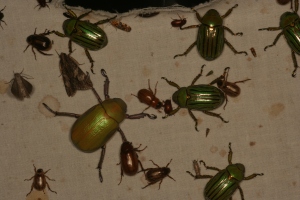 old friends and no longer feel the urge to collect them in long series, if at all. I have heard stories of collectors and dealers with considerably less restraint collecting hundreds of specimens from the same mountain canyons, year after year. This annual carnage has led some people to wonder out loud whether or not Arizona’s Chrysina are in real need of some sort of legal protection. Nearly 30 years ago, Arnett and Jacques (1981) declared that both C. beyeri and C. gloriosa, which they mistakenly thought were the only species in the United States, were “…endangered and should not be collected.” However, on a warm and dry night in Madera Canyon this past July, all three species of Arizona’s Chrysina turned up at my light in good numbers. One species, C. gloriosa, was there in incredible abundance. Still, it would be worthwhile for a university or governmental agency to study the overall impact of intensive collecting on Chrysina populations in Madera Canyon and other popular collecting sites in southeastern Arizona.
old friends and no longer feel the urge to collect them in long series, if at all. I have heard stories of collectors and dealers with considerably less restraint collecting hundreds of specimens from the same mountain canyons, year after year. This annual carnage has led some people to wonder out loud whether or not Arizona’s Chrysina are in real need of some sort of legal protection. Nearly 30 years ago, Arnett and Jacques (1981) declared that both C. beyeri and C. gloriosa, which they mistakenly thought were the only species in the United States, were “…endangered and should not be collected.” However, on a warm and dry night in Madera Canyon this past July, all three species of Arizona’s Chrysina turned up at my light in good numbers. One species, C. gloriosa, was there in incredible abundance. Still, it would be worthwhile for a university or governmental agency to study the overall impact of intensive collecting on Chrysina populations in Madera Canyon and other popular collecting sites in southeastern Arizona.
Commonly known as jewel scarabs, the genus Chrysina is replete with incredibly beautiful, often metallic species. It includes nearly 100 species, most of which occur in Mexico and Central America. The four species in the United States are relics of a rich Neotropical fauna that expanded northward during more favorable (wetter) periods. For the past 10,000 years or so, these species were able to adapt to an increasingly warmer and drier climate by taking refuge in the high elevations of mountains.

Weldon Heald
The Southwest mountains inhabited by Chrysina are like stepping stones that bridge the gap between the temperate flora and fauna of the Rocky Mountains of the United States and the tropical biota of the Sierra Madre Occidental of Mexico. This archipelago of mountain “islands” in southeastern Arizona, southwestern New Mexico, and northern Mexico are surrounded by hot, dry desert “seas.” As such, they were dubbed “Sky Islands” nearly 60 years ago by the natural history writer Weldon Heald. Arizona’s Sky Islands are home to three species of Chrysina; the fourth American species is found in Texas.
All four of the American jewel scarabs were originally described in the genus Plusiotis. As a result of morphological and DNA evidence, the newer name Plusiotis was deemed redundant in relation to the older monicker Chrysina and it was formally synonymized by Dave Hawks (2001). The first species known in the United States, the glorious jewel scarab (C. gloriosa), was described by the father of American 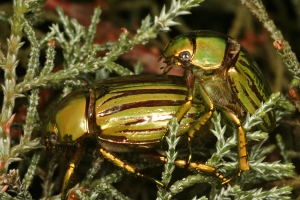 coleopterology, John L. LeConte in 1854. LeConte described this emerald-green and silver-striped species based on specimens collected at a copper mine in Texas that are now in the Museum of Comparative Zoology (MCZ) at Harvard. These specimens were collected by the Secretary of the United States and Mexican Boundary Commission, Thomas Hopkins Webb. A physician from Rhode Island, Webb was appointed Secretary of the Commission in 1850, a position he held until 1854. In addition to his full-time position as Secretary, Webb enthusiastically collected insects, fishes, and reptiles and sent them to the leading authorities of the day. Later, he would become the secretary and principal executive officer of the Massachusetts Institute of Technology.
coleopterology, John L. LeConte in 1854. LeConte described this emerald-green and silver-striped species based on specimens collected at a copper mine in Texas that are now in the Museum of Comparative Zoology (MCZ) at Harvard. These specimens were collected by the Secretary of the United States and Mexican Boundary Commission, Thomas Hopkins Webb. A physician from Rhode Island, Webb was appointed Secretary of the Commission in 1850, a position he held until 1854. In addition to his full-time position as Secretary, Webb enthusiastically collected insects, fishes, and reptiles and sent them to the leading authorities of the day. Later, he would become the secretary and principal executive officer of the Massachusetts Institute of Technology.
 According to my friend, colleague, and Arizona scarabaeologist Bill Warner, C. gloriosa occurs in nearly all of the mountain ranges in at least the southern three-quarters of the state where their food plant, Juniperus, grows. Glorious jewel scarabs also occur in New Mexico, and Texas, as well as the Mexican states of Chihuahua and Sonora. With the onset of the summer monsoons, adults often spend their daylight hours feeding and resting on junipers; they are commonly attracted to lights at night, sometimes in large numbers.
According to my friend, colleague, and Arizona scarabaeologist Bill Warner, C. gloriosa occurs in nearly all of the mountain ranges in at least the southern three-quarters of the state where their food plant, Juniperus, grows. Glorious jewel scarabs also occur in New Mexico, and Texas, as well as the Mexican states of Chihuahua and Sonora. With the onset of the summer monsoons, adults often spend their daylight hours feeding and resting on junipers; they are commonly attracted to lights at night, sometimes in large numbers.
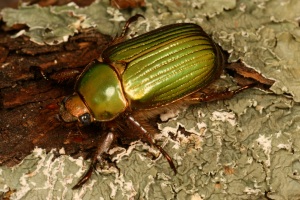 In 1882, two years after LeConte’s death, another prominent coleopterist named George Horn described the second American species of Chrysina, LeConte’s jewel scarab (C. lecontei). His description was based on three examples now housed at the MCZ. These included one specimen from Tucson in the cabinet of England-born actor and entomologist Henry Edwards, another from LeConte’s cabinet collected in New Mexico by the curator of the insect collection at the University of Kansas, Professor Francis H. Snow, and a series in his own collection from Prescott, Arizona. Without any fanfare whatsoever, Horn ended his description by quietly dedicating the new species “to a friend.”
In 1882, two years after LeConte’s death, another prominent coleopterist named George Horn described the second American species of Chrysina, LeConte’s jewel scarab (C. lecontei). His description was based on three examples now housed at the MCZ. These included one specimen from Tucson in the cabinet of England-born actor and entomologist Henry Edwards, another from LeConte’s cabinet collected in New Mexico by the curator of the insect collection at the University of Kansas, Professor Francis H. Snow, and a series in his own collection from Prescott, Arizona. Without any fanfare whatsoever, Horn ended his description by quietly dedicating the new species “to a friend.”
Warner notes that LeConte’s jewel scarab has essentially the same range in Arizona as the glorious jewel scarab, but that it is a bit more restricted to the higher altitudes where its food plant, the ponderosa pine, occurs. This species also occurs in New Mexico and the Mexican states of Chihuahua, Durango, Sinaloa, and Sonora.
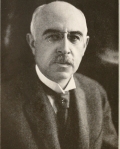
Henry Skinner
The third American species of Chrysina was first exhibited by Horn on November 9, 1883 at a meeting of the entomological section of the Academy of Natural Sciences in Philadelphia. He presented two specimens collected in Rio Grande, Texas by his friend and Philadephia physician, Dr. Horatio C. Wood. Wood was a pioneer in American pharmacology who published numerous papers on pharmacology, physiology, and experimental therapeutics and taught neurology and internal medicine at the University of Pennsylvania. Early in his career Wood published papers in botany, entomology, and myriapodology. He traveled to the borderlands to collect specimens for the Smithsonian Institution and was one of the first white men to see the Grand Canyon. Wood recalled to lepidopterist Dr. Henry Skinner (1905) that the beetles he had given to Horn were either collected near El Paso, Texas, or in the valley of Tornellias [Tornillo] Creek at the great bend of the Rio Grande. The beetles were described in the minutes for the meeting as “pale malachite green, narrowly bordered with pale gold, the elytra are not striate, but with rows of fine punctures, the tarsi are beautifully violet.” Horn formally described Wood’s jewel scarab, Chrysina woodii, in 1885. These specimens are also housed in the MCZ. Horn noted that he saw another specimen in the Museum of the Jardin des Plantes in Paris. Wood’s jewel scarabs eat the leaves of walnut trees and are apparently diurnal, although some individuals are attracted to lights at night. It also occurs in Chihuahua, Mexico.
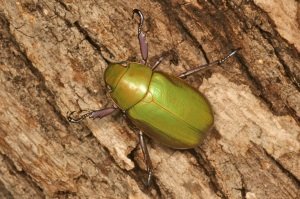 In 1905, Skinner, a gynecologist as well as co-founder and editor (1890-1910) of the Entomological News, described Beyer’s jewel scarab (C. beyeri) from four specimens collected in Carr and Miller Canyons in the Huachuca Mountains in southeastern Arizona. This handsome species first came to his attention the previous year when a specimen was sent to him from Reef in Cochise County. Reef was a mining camp in the southwest corner of Cochise County near the Mexican border. It was located in Carr Canyon in the Huachuca Mountains and was named for a noted landmark Carr Reef, an exposed and thick layer of rock. The site is now a campground in the Coronado National Forest. Skinner examined additional specimens presumably collected from the same locality by Beyer, Schaeffer, and Biederman. The Reef post office was officially relocated to Palmerlee (at the base of Miller Canyon) in December of 1904.
In 1905, Skinner, a gynecologist as well as co-founder and editor (1890-1910) of the Entomological News, described Beyer’s jewel scarab (C. beyeri) from four specimens collected in Carr and Miller Canyons in the Huachuca Mountains in southeastern Arizona. This handsome species first came to his attention the previous year when a specimen was sent to him from Reef in Cochise County. Reef was a mining camp in the southwest corner of Cochise County near the Mexican border. It was located in Carr Canyon in the Huachuca Mountains and was named for a noted landmark Carr Reef, an exposed and thick layer of rock. The site is now a campground in the Coronado National Forest. Skinner examined additional specimens presumably collected from the same locality by Beyer, Schaeffer, and Biederman. The Reef post office was officially relocated to Palmerlee (at the base of Miller Canyon) in December of 1904.
Gustav Beyer was a fur manufacturer from New York and an indefatigable insect collector who frequently travelled with his friend and Curator of Coleoptera at the Brooklyn Museum Institute of Arts and Sciences, Charles F. A. Schaeffer. Schaeffer spent a considerable amount of time collecting beetles at his three favorite haunts: Mt. Mitchell in North Carolina, the Lower Rio Grande Valley in Texas, and the Huachuca Mountains. Charles R. Biederman, a veteran of the Confederate Army and a resident of the Huachuca Mountains, was an ardent insect collector and is buried on his homestead in Carr Canyon. Before the advent of collecting Chrysina and other nocturnal beetles at light, both Biederman (1907) and another collector, Karl Coolidge (1911), noted a decided lack of success in obtaining specimens of C. beyeri, in spite of considerable searching about trees and in leaf litter. After finding a single specimen of C. beyeri in leaf litter, Biederman raked nearly two acres of leaves to find more beetles, but came up empty handed.
Beyer’s jewel scarab has the most restrictive distribution of all Arizona’s Chrysina and is known only from the Santa Rita, Patagonia, and Huachuca Mountains; it also occurs in the Animas Mountains of New Mexico and the states of Chihuahua and Sonora, Mexico. Adults feed on the leaves of Mexican blue oak, Quercus oblongifolia.
In 1915, Colonel Thomas Lincoln Casey, a noted and somewhat controversial coleopterist, described several species of Plusiotis, all of which have long been considered synonyms of the previously mentioned species.
Arizona’s jewel scarabs are not only popular with collectors and macro photographers, they also serve as wonderfully instructive subjects for scientific study, especially for scientists seeking to understand the physical qualities and adaptive significance of their brilliant colors. More on this subject will appear in the second and final installment of “Reflections on Arizona’s Jewel Scarabs.”
Sources:
Arnett, R. H., Jr, and R. L. Jacques. 1981. Simon & Schuster’s Guide to Insects. New York: Simon & Schuster. 511 pp.
Barnes, W. C. 1988. Arizona Place Names. Tucson, AZ: University of Arizona Press.
Biederman, C. R. 1907. Notes on Plusiotis beyeri Skinner. Entomological News 18: 7-9.
Burke, H. R. 2004. Notable Weevil Specialists of the Past. Charles Frederick August Schaeffer (1860-1934). Curculio 49: 5-7. Accessed on 26 September 2010 at: <http://www.texasento.net/Schaeffer.html#Burke>.
Calvert, P. P. 1926. The entomological work of Henry Skinner. Entomological News 37: 225-249.
Coolidge, K. R. 1911. Plusiotis beyeri Skinner. Entomological News 22: 326-327.
Evans, A. V. 2007. National Wildlife Federation Field Guide to Insects and Spiders of North America. New York: Sterling. 497 pp.
Hawks, D. 2001. Taxonomic and nomenclatural changes in Chrysina and a synonymic checklist of species (Scarabaeidae: Rutelinae). Occasional Papers of the Consortium Coleopterorum 4(1): 1-8.
Hawks, D. 2001. Checklist of Chrysina species (Scarabaeidae: Rutelinae: Rutelinae). (URL: http://www.unl.edu/museum/research/entomology/Guide/Scarabaeoidea/Scarabaeidae/Rutelinae/Rutelinae-Tribes/Rutelini/Chrysina/Chrysina-Catalog/ChrysinaC.html). In B.C. Ratcliffe and M.L. Jameson (eds.), Generic Guide to New World Scarab Beetles (URL: http://www-museum.unl.edu/research/entomology/Guide/Guide-introduction/Guideintro.html). Accessed on: 27 September 2010.
Horn, G. H. 1882. Notes on some little known genera and species of Coleoptera. Transactions of the American Entomological Society 10(1): 113-
Horn, G. H. 1885. New North American Scarabaeidae. Transactions of the American Entomological Society. 12: 117-128.
LeConte, J. L. 1854. Descriptions of the Coleoptera collected by Thos. H. Webb, M.D., in the years 1850-51 and 52, while Secretary of the U.S. and Mexican Boundary Commission. Proceedings of the Academy of Natural Sciences of Philadelphia 7: 220-225.
Leng, C. W. 1924. Gustav Beyer. Journal of the New York Entomological Society 32(4): 165-166.
Quincy, J. P. 1882. Memoir of Thomas Hopkins Webb. Proceedings of the Massachusetts Historical Society 19: 336-338.
Roth, G.B. 1939. An early American pharmacologist. Horatio C. Wood. 1841-1920. Isis 30(1): 38-45.
Skinner, H. 1905. Descriptions of new Coleoptera from Arizona with notes on some other species. Entomological News 16: 289-292.
© 2010, A.V. Evans
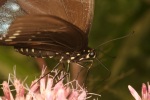 Several tall and luxurious patches of sweet-scented joe pye weed, Eupatorium purpureum, grew smack dab in the middle of the power line right-of-way. These nectar-rich flowers were magnets for all kinds of insects (other than beetles!), including several species of butterflies. A dozen or so each of large showy eastern tiger swallowtails and monarch butterflies flitted from blossom to blossom, occasionally unfurling their probosces to imbibe the flower’s sweet offerings.
Several tall and luxurious patches of sweet-scented joe pye weed, Eupatorium purpureum, grew smack dab in the middle of the power line right-of-way. These nectar-rich flowers were magnets for all kinds of insects (other than beetles!), including several species of butterflies. A dozen or so each of large showy eastern tiger swallowtails and monarch butterflies flitted from blossom to blossom, occasionally unfurling their probosces to imbibe the flower’s sweet offerings.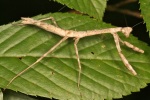 the edge of a recent prescribed burn. I scanned the lush wall of vegetation that delimited the surrounding woods from the burn in hopes of finding multi-legged creatures. Nearly half an hour elapsed and all I had to show for my photographic efforts was a young Carolina mantid (Stagmomantis carolina) and a black-and-yellow garden spider (Argiope aurantia).
the edge of a recent prescribed burn. I scanned the lush wall of vegetation that delimited the surrounding woods from the burn in hopes of finding multi-legged creatures. Nearly half an hour elapsed and all I had to show for my photographic efforts was a young Carolina mantid (Stagmomantis carolina) and a black-and-yellow garden spider (Argiope aurantia). Just as I was about to take a photograph, she was gone. Fortunately, I saw her land on a nearby leaf and she was still very much in possession of her lifeless prey. I leaned in to take the shot and, with the burst of my flash, she took to the air again. I watched intently as the shiny black fly flitted along the wood’s edge and landed on another leaf. Again, I slowly inched my camera toward her and watched her black shiny body fill up the frame of my viewfinder. And again, the flash of my camera caused her to fly away and into the burn area. I tracked her through several more landings on the low growth before she landed on a log. I took my third and last shot and she was gone. During the pursuit, a slightly smaller individual of the same species, possibly a male, also crossed my path.
Just as I was about to take a photograph, she was gone. Fortunately, I saw her land on a nearby leaf and she was still very much in possession of her lifeless prey. I leaned in to take the shot and, with the burst of my flash, she took to the air again. I watched intently as the shiny black fly flitted along the wood’s edge and landed on another leaf. Again, I slowly inched my camera toward her and watched her black shiny body fill up the frame of my viewfinder. And again, the flash of my camera caused her to fly away and into the burn area. I tracked her through several more landings on the low growth before she landed on a log. I took my third and last shot and she was gone. During the pursuit, a slightly smaller individual of the same species, possibly a male, also crossed my path.


